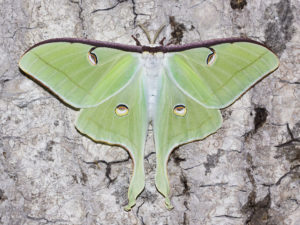Luna Moth (Actias luna)
The Luna moth is a saturniid moth found in North America. It is part of the subfamily called the giant silk moths.
The moth was initially described by a London apothecary, James Petiver in 1700. However, it was given its current designation in 1758 by famed Swedish zoologist Carl Linnaeus in the 10th edition of his book Systema Naturae.
Scientific Classification
- Family: Saturniidae
- Genus: Actias
- Scientific Name: Actias luna
Description and Identification
Caterpillar
The larva goes through five instars, with each instar lasting for 4-10 days. The instars are generally green, though the first two have underlying black splotches dorsally. Fully mature caterpillars can reach 9 cm in length. The setae, found on the thoracic and abdominal segments, are not poisonous like some other species.
Pupa
Pupation takes place inside a thin and single-layered silk cocoon for two weeks. However, it may also overwinter for nine months. Before pupation, a mature caterpillar takes on a reddish-brown color and expels excess water and intestinal contents. Compared to other moths, these pupae are more active, wiggling within their pupal cases if disturbed. Sometimes these movements generate noise as well.
Adult Moth
Sexual Dimorphism: Present. Females have a larger abdomen than males due to the increased number of eggs they carry between 200 and 400. On the other hand, the males have longer and wider antennae.
Color and Appearance
When the wings are opened, they are lime-green with eyespots on all four wings that have black, yellow, red, blue, green, or white arcs. In fact on the forewings the eyespots appear oval, while on the hindwings they are round. Long, and flowing tail-like structures are seen extending from behind their hindwings.
When the wings are closed, the color, and pattern remain unchanged with two of the four eyespots visible, alongside the extended tail.
These moths overall have a white and hairy body.
Average wingspan: 8–11.5 cm
Flight pattern: Erratic
Season: Late May or early June
Quick Facts
| Other names | American Moon Moth |
| Distribution | North America, ranging from east of the Great Plains in the United States – Florida to Maine, and from Saskatchewan eastward through central Quebec to Nova Scotia in Canada. Some individuals have been spotted in western Europe. |
| Habitat | Deciduous forests |
| Lifespan of Adults | 1 week |
| Predators | Bald-face hornets, bats, fiery searcher ground beetles, owls, and parasitic wasps |
| Host Plants | Mainly white birch. Also, alder, beech, black walnut, butternut, hickory, persimmon, sumac, sweetgum, wild cherry, or willow |
| Adult Diet | Does not feed as their mouthparts are not developed |
Did You Know
- The Luna moth is the only moth to be honored by the American postal service, with a first-class postage stamp depicting it. This stamp was printed in June 1987.
- This moth has been featured in several songs, like the R.E.M songs You and Boy in the Well and the Big Thief song Strange.
Scientific Classification
- Family: Saturniidae
- Genus: Actias
- Scientific Name: Actias luna












